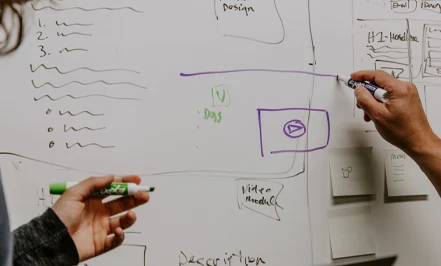
A Step-by-Step Guide To Gathering Software Requirements For Successful Development

by Josh Watkinson,
07-Nov-2023
In software development, it's easy to become fixated on the technicalities of programming languages, design patterns, and architectures. Yet, the true foundation of any successful project lies not within code, but in fully understanding what that code is meant to achieve.
Ignoring or merely sidelining software requirements can be akin to starting a journey without a detailed map or even a clear destination. It is a gamble that often culminates in wasted resources, disappointed stakeholders, and lost opportunities. Let's avoid this pitfall together.
Understanding and collecting software requirements is a cornerstone of any successful development project. It’s a process that needs equal parts of care, attention, and technical knowledge. Missteps can lead to a misalignment between the delivered software and business needs.
In this guide, we will walk you through a step-by-step process of gathering precise and effective software requirements.
Understanding the Business Context
Before diving into software specifics, developers need to get to grips with the business context. This involves understanding the company's strategic goals, market positioning, and the problem the software aims to solve. You need to evaluate how the software will interact with other systems in the business ecosystem and measure the impacts on end-users and stakeholders.
Defining Functional and Non-Functional Requirements
Central to software requirement gathering is the clear definition of what the software must do (functional requirements) and how it should perform (non-functional requirements).
Functional requirements are actions that a system must be able to perform. They can range from user features, data manipulation, to business processes.
Non-functional requirements are equally crucial, addressing system performance, security, usability, and reliability. They describe how the system is supposed to be rather than what it's supposed to do. Read more on understanding and optimising your software through agile development methods from our blog post.
Utilising Requirement Gathering Techniques
There is a broad spectrum of techniques available for requirements gathering, from one-on-one interviews, brainstorming sessions, and user surveys to more formal methods like use-case analysis and business process modelling. The choice of techniques should depend on the business context, available resources, and project complexity.
Documenting and Validating Requirements
Once requirements are gathered, they need to be documented in a structured and clear manner. This record serves as a contract between stakeholders and development teams. Requirements should be properly categorised, and their sources correctly cited. Also, it's essential to have a formal validation process to review and confirm accuracy.
Managing Requirement Changes
Requirement changes are an inescapable reality in software development. The key is to manage these changes effectively to minimise delays and cost overruns. This requires a streamlined change management process that includes precise tracking, analysis, and approval/rejection procedures.
Now that we've covered the steps to gather requirements, let's take an illustrative example. Suppose we're building a mobile app to enhance collaborative work among remote teams. We will follow these stages:
- Understanding the Business Context: The software is aimed at facilitating remote team collaboration, boosting productivity, and improving project management in a remote environment.
- Defining Functional and Non-Functional Requirements: The functional requirements could include chat capabilities, document sharing, task assignments, and scheduling. Non-functional requirements could include an intuitive interface, data security measures, and fast response times.
- Utilising Requirement Gathering Techniques: We could use interviews with remote teams to identify their needs, survey the user base for feature requests, and create use-case scenarios.
- Documenting and Validating Requirements: All the gathered requirements will be documented and validated before moving on to development stages.
- Managing Requirement Changes: Throughout development, changes to requirements will be tracked and managed effectively to ensure alignment with business needs.
By following these steps and techniques, you can ensure a more streamlined and successful software development process. If you're part of a startup and feel the complexities getting overwhelming, it could be beneficial to collaborate with a development partner. Successful software development starts with precise and comprehensive requirements gathering, and we hope this guide has shed some light on this critical process.
Navigating the complexities of a software development project can be daunting, but you don't have to do it alone. At Datamango, we provide a partnership that goes beyond basic service provision. We work hand-in-hand with our clients to ensure their software's functionality and performance are perfectly attuned to their unique needs and objectives. From initial requirement gathering to final product development, our team of seasoned professionals will support you every step of the way. Get in touch with us today and let us help you transform your software aspirations into a tangible, value-adding reality.
Want to get a head start on gathering requirements for you development project?




